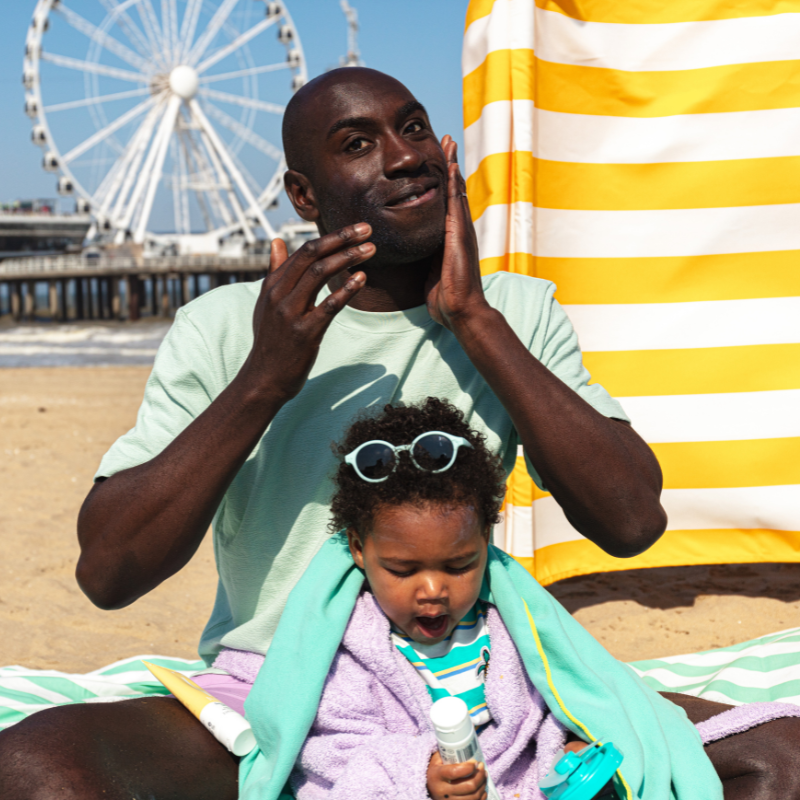Sun protection
What's the deal with UV filters?
11 February 2024

We've talked about it many times: UV filters. The most important ingredient in sunscreen, cause yeah it's the UV filter that protects you from the sun. But what is a UV filter and how does it work? And what about the different kinds of UV filters? No worries, we are here to help you understand!
How does sunscreen actually work? We don’t mind explaining! The magic ingredient in sunscreen is its UV filter. Sometimes a UV filter gets added to other care products as well, for example day cream, and there even is special UV clothing available. Talking about maximum protection, because the UV filter makes going out in the sun a lot safer for your skin! A UV filter protects the skin from harmful sun rays, which is called UV radiation. There are two kinds of UV radiation: UVA (ages the skin) and UVB (causes sunburn). Naïf sunscreen protects the skin against both UVA and UVB.
Two kinds
When talking about UV filters, there is often a distinction made between two kinds: mineral and chemical, but we rather call this non-mineral. The biggest difference between them is the way in which they are made. A mineral UV filter is made from a naturally occurring ingredient and creates a protective layer on top of the skin. This way a mineral UV-filter offers immediate protection after application. A non-mineral filter is lab-made and protects the skin from within. The filter penetrates the skin after which a chemical reaction takes place. This might sound a little dangerous, but it doesn’t have to be. Everything around us is made up of chemical reactions. But is does usually take about 20 minutes before you can enjoy the sun after applying a non-mineral sunscreen, because the skin is only well protected after the filter is ‘activated’.
A non-mineral filter is not necessarily bad or dangerous, but they did get a bit of a bad name in recent years. This is because many UV-filters that are lab-made turn out to contain ingredients that appear to be harmful to the skin or environment. That’s why we choose to stay away from the following ingredients:
octinoxate
octocrylene
oxybenzone
avobenzone
homosalate
butyl octyl salicylate
Mineral sunscreen
In our formula we have been using non-nano zinc oxide based UV filter. Mineral it is! And that's with good reason. We believe that mineral sunscreen is better. Zinc oxide is a mineral that adds a protective layer on top of the skin that reflects the sun. Like a mirror! Because the zinc oxide does not penetrate the skin there is a minimum chance to get an allergic reaction and it offers immediate protection. Annually 14 million kilograms of sunscreen ends up in the ocean. You can imagine how important it is to use a sunscreen with a UV filter that does not have any negative effects on the ocean. Oxybenzone and octinoxate based UV filters are proven to be harmful to coral reefs. That’s why we stay away from these, and all ingredients that are a potential risk, and we chose to create a mineral sunscreen with a zinc oxide based UV filter.
New generation UV filters
But there is good news, because there is a new generation of non-mineral UV filters. These filters are lab-made, but do not penetrate the skin. They offer immediate protection as well with a minimum chance of irritated skin. Suitable for the sensitive skin and a great step in the right direction!
Mineral sunscreen is not always the most user friendly, that's why we improve our formula every year. Not to make it better per se, because it is already good, but to make it easier to apply and reduce the white cast it can leave on the skin after application. This year we added a second booster. The new booster is made of a new generation UV filter: bis-Ethylhexyloxyphenol Methoxyphenyl Triazine. This UV filter is lab-made, but does not penetrate the skin and offers protection from the outside. And of course it is not harmful to the planet, it’s completely safe!
Want to read more about our changed formula, sure thing!